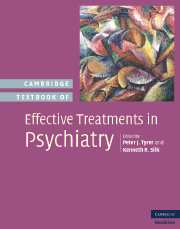Book contents
- Frontmatter
- Contents
- List of contributors
- Preface
- Part I Introduction
- 1 Classification of psychiatric disorders and their principal treatments
- 2 The history of psychiatric therapies
- Part II Summary of treatment modalities in psychiatric disorders
- Part III Specific treatments
- Appendix I Summary of specific drugs having evidence of effectiveness in mental disorders
- Appendix II Key to effectiveness tables
- Index
- References
1 - Classification of psychiatric disorders and their principal treatments
from Part I - Introduction
Published online by Cambridge University Press: 12 May 2010
- Frontmatter
- Contents
- List of contributors
- Preface
- Part I Introduction
- 1 Classification of psychiatric disorders and their principal treatments
- 2 The history of psychiatric therapies
- Part II Summary of treatment modalities in psychiatric disorders
- Part III Specific treatments
- Appendix I Summary of specific drugs having evidence of effectiveness in mental disorders
- Appendix II Key to effectiveness tables
- Index
- References
Summary
A kind of thought compulsion, a logical and aesthetic necessity, insists that we seek for well-defined, self-contained, clinical entities; but unfortunately our subjective need is no proof of the reality of which we desire.
(Hoche, 1910)Despite many proposed candidates, not one laboratory marker has been found to be specific in identifying any of the DSM-defined syndromes. Epidemiologic and clinical studies have shown extremely high rates of comorbidity among the disorders, undermining the hypothesis that the syndromes represent distinct etiologies. Furthermore, epidemiologic studies have shown a high degree of short-term diagnostic instability for many disorders. With regard to treatment, lack of treatment specificity is the rule rather than the exception.
(Kupfer et al., 2002, p. xvii)Introduction
Why, you may well ask, has a book about treatment found it necessary to begin with a section on diagnosis? Since the introduction of DSM–III (American Psychiatric Association, 1980), diagnosis has seemed to become the ‘holy grail’ of psychiatry. Yet currently, diagnosis is in the doghouse, as the quotations above, spanning nearly a hundred years, illustrate. But, even though we despair at regular intervals, we continue to want a nice clean system that allows psychiatric patients to be pigeon-holed by clever clinicians who then have both an explanation of a disorder and its solution. For the hope has always been that if a specific diagnosis is made correctly, that the proper and best treatment will follow almost automatically.
- Type
- Chapter
- Information
- Publisher: Cambridge University PressPrint publication year: 2008
References
- 1
- Cited by



